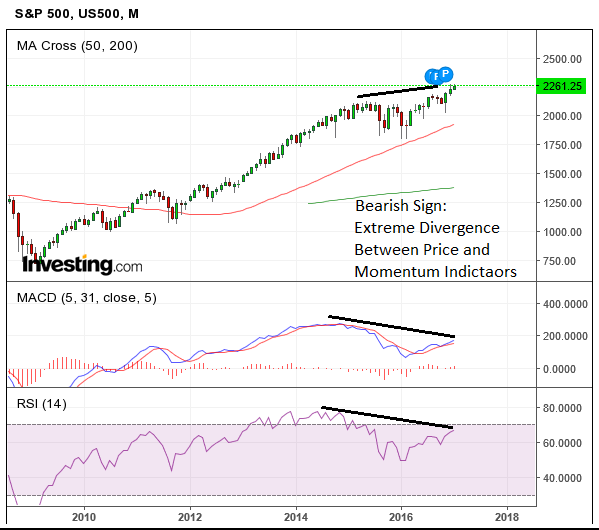The S&P 500 May Have Already Peaked say Capital Economics

The strong cyclical uptrend in US stocks could be nearing completion suggests new analysis from a leading independent research house.
In particular, the headline S&P 500 (INDEXSP:.INX) share index is close to peaking argues economist John Higgins of Capital Economics.
“We think that the S&P 500 will only rise a little bit further over the next couple of years and then probably tumble as the US economy takes a turn for the worse,” says Higgins in a note to clients issued this week.
Although it rose strongly following the financial crisis, since 2014 the index has been trading in a fairly narrow range.
“We doubt that this pattern is set to change in the first couple of years of Trump’s presidency. Indeed, we forecast that the index will end this year and next at 2,300 and 2,400, respectively, which would be small gains from its current level of around 2,270,” says Higgins.
The rationale behind this view is based on the US economy’s relatively late stage of evolution in the Economic cycle.
Unemployment has fallen by over 50% since the recession and is close to its “natural” level and this is likely to translate into higher wages.
Higher wages will then,in turn, eat into company profits, leading to a fall in the value of their shares, which in turn will lower the S&P-500.
Although Higgins acknowledges there are supporting factors, such as continued share buy-backs, in which a company spends its profits on buying its own shares, as well as faster growth in profits for multi-nationals from their subsidiaries in the world at large, exist, they too could be undermined themselves by currency erosion.
Higgins sees a stronger rather than a weaker Dollar on the horizon, as the Fed is set on a course of raising interest rates, which it is unlikely to deviate from, and higher interest rates will strengthen the Dollar.
If Unemployment falls any lower, it is likely to keep the Price to Earnings ratio subdued according to research.
“In the past, the price/earnings multiple of the S&P 500 has tended to track a sideways path when the unemployment rate has fallen well below its natural level,” notes Higgins.
“As a result, the S&P 500 has only tended to edge up on the eight occasions since 1950 when this has happened. The average gain in the index has been roughly 4% a year, about half its average over the period,” continues the Economist.
The longer-term outlook is also likely to look “bleaker” for Trump’s “team” too as higher interest rates will make borrowing more expensive for businesses and individuals, making, “The risk of a recession is, therefore, high,” according to Higgins.
The economist notes that major corrections of stock markets often occur about 6-months before a recession.
“The upshot is that we think that the next big move in the S&P 500 will be down, perhaps in 2019. A fall of 20% or more seems plausible, especially as the valuation of the index is on the high side.,” he concludes.
Technical Evidence Supports Potential Pull-Back
The S&P-500 monthly chart supports Capital Economics’ bearish outlook.
The price has made higher highs but this has not been matched by momentum, especially at the current 2278 peak.
This non-confirmation with both MACD and RSI momentum indicators and the wide degree of divergence is an early warning signal the market is about to fall.









